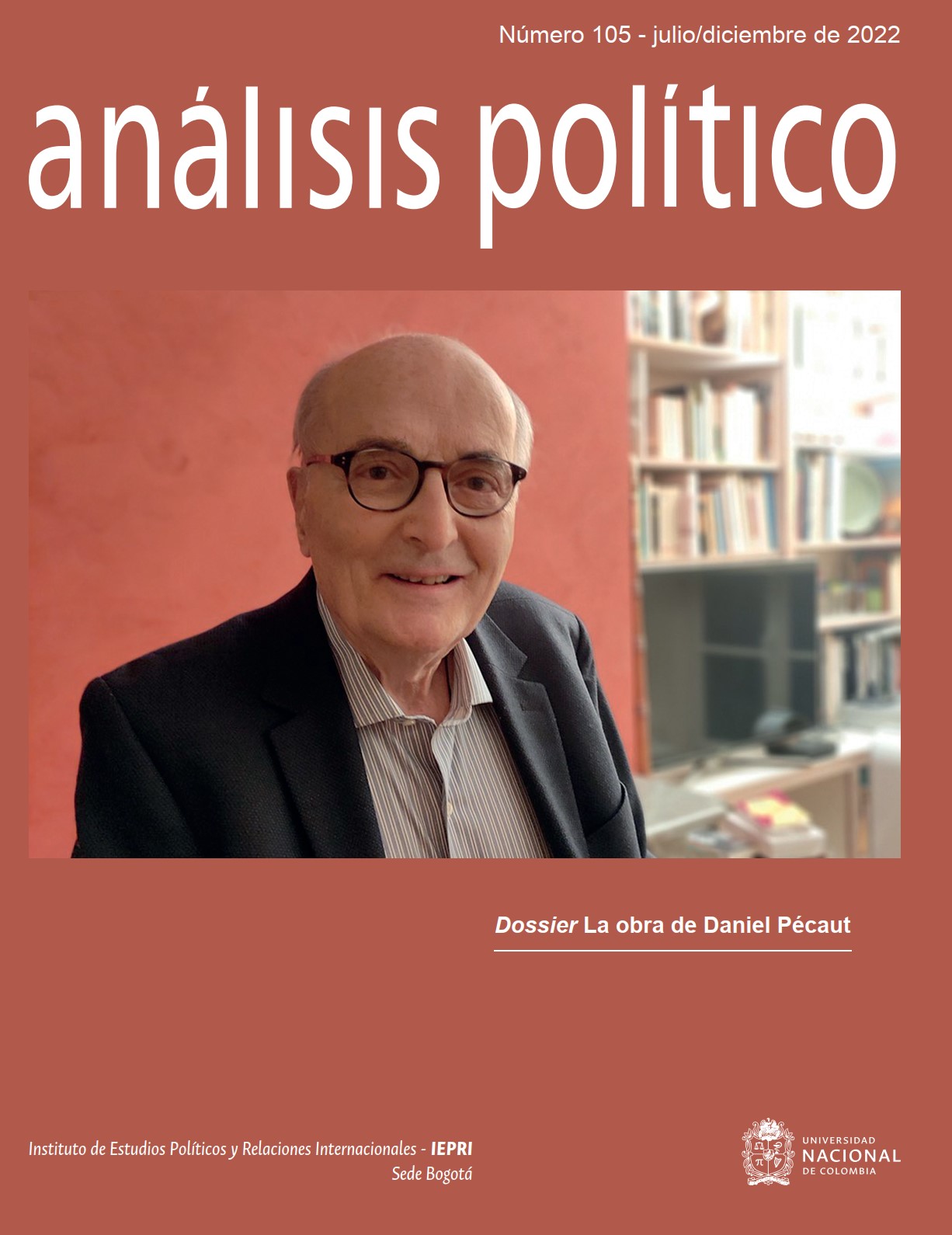Septiembre de 2021: el triunfo islamista de los talibanes
September 2021: The Islamist Triumph of the Taliban
DOI:
https://doi.org/10.15446/anpol.v35n105.107759Palabras clave:
Afganistán, talibanes, Pakistán, Estados Unidos, geopolítica (es)Afghanistan, Taliban, Pakistan, United States, geopolitics (en)
Descargas
El triunfo de los talibanes en Afganistán, tras la salida de tropas estadounidenses, tiene como consecuencia no solo importantes transformaciones sobre la sociedad afgana, sino también un cambio radical en la acción geoestratégica de las potencias con interés en Asia Central. Comprender los últimos acontecimientos de violencia en Afganistán implica remontarse al origen del fenómeno talibán, a las alianzas políticas que se crearon desde antes de la Guerra Fría, a la presencia de Al Qaeda y a la intervención de Estados Unidos después de los ataques del 11 de septiembre de 2001. Este capítulo se cierra, por el momento, con el fallido intento de las potencias occidentales de transformar un territorio caracterizado por luchas intertribales, corrupción sistémica y el retorno de los talibanes al poder de un Estado débil, pero con importantes apoyos internacionales que suponen cambios en la geopolítica mundial.
The success of the Taliban in Afghanistan, following the withdrawal of US troops, has resulted not only in remarkable changes in Afghan society but also in a radical shift in the geostrategic action of powers interest in Central Asia. Understanding the latest events of violence in Afghanistan implies going back to the origins of the Taliban phenomenon, the political alliances created before the Cold War, the presence of Al Qaeda, and the intervention of the United States after the attacks of 9/11, 2001. This chapter closes, for the moment, with the failed attempt of Western powers to transform a territory, characterized by inter-tribal struggles, systemic corruption, and the return to the power of the Taliban in a weak state but with significant international support, which supposes substantial changes in global geopolitics.
Referencias
BBC News. (2021, 16 de agosto). Mapping the advance of the Taliban in Afghanistan. https://www.bbc.com/news/world-asia-57933979
Burnes, A. (2012). Travels into Bokhara. Vol. 3. Nabu Press.
Chandran, S. (2006). Limited war: Revisiting Kargil in the Indo-Pak Conflict. India Research Press.
Cordovez, D., & Harrison, S. S. (1995). Out of Afghanistan: The inside story of the soviet withdrawal. Oxford University Press. DOI: https://doi.org/10.1093/oso/9780195062946.001.0001
Cottey, A. (2002). Afghanistan and the new dynamics of intervention: counter-terrorism and nation building. En SIPRI Yearbook 2003: Armaments, Disarmament and International Security (pp. 167-194). SIPRI.
Duarte, P. (2013). Central Asia as the crossroads of great powers' competition: Present vs. Past. Humania del Sur. https://doi.org/10.1093/acprof:oso/9780199929825.001.0001
Edwardes, M. (1958). The Necesary Hell. John and Henrry Lawrence and the Indian Empire. Cassell.
Ghasemi, M. E. (1999). Islam, International Human Rights & (and) Women's Equality: Afghan Women under Taliban Rule. Southern California Review of Law and Women's Studies, 8(2), 445-468.
Gill, J. H. (2019). Provocation, war and restraint under the nuclear shadow: The Kargil conflict 1999. Journal of Strategic Studies, 42, 701-726. DOI: https://doi.org/10.1080/01402390.2019.1570144
Harvey, K. (2003, 5 de junio). Afghanistan, The United States, and the Legacy of Afghanistan’s Civil War. Standford University. https://web.stanford.edu/class/e297a/Afghanistan,%20the%20United%20States.htm
Haass, R. N. (2009). War of necessity, war of choice. A memoir of two Irak wars. Simon & Schuster.
Hostalier, F. (2020). L’Afghanistan, état de guerre permanent. Revue Défense Nationale, 89-98. DOI: https://doi.org/10.3917/rdna.829.0089
The International Institute for Strategic Studies (IISS). (2020). The Military Balance 2020. Routledge.
Johnson, C., Maley, W., Thier, A., & Wardak, A. (2003). Afghanistan’s political and constitutional development. Overseas Development Institute. https://cdn.odi.org/media/documents/5888.pdf
Jouanneau, D. (2020). Un arc de crise sous-estimé: Inde-Pakistan-Afghanistan. Revue Défense Nationale, 137-146. DOI: https://doi.org/10.3917/rdna.831.0137
Kakar, H. (1978). The fall of the Afghan monarchy in 1973. International Journal of Middle East Studies, 9, 195-214. DOI: https://doi.org/10.1017/S0020743800000064
Lavoy, P. (2009). Asymmetric warfare in South Asia: The causes and consequences of the Kargil Conflict. Cambridge University Press. DOI: https://doi.org/10.1017/CBO9780511691805
Le Monde. (2021, 15 de septiembre). Le Qatar au centre du jeu diplomatique afghan .
López, F. B. (2017). La polarización política de la sociedad afgana y su fracaso democrático (1973-2001). Revista de Estudios en Seguridad, 3(1), 81-101. DOI: https://doi.org/10.18847/1.5.5
Masson, C. (1844). Narrative of Various Journeys in Balochistan, Afghanistan, the Panjab, and Kalât. Richard Bentley.
Rashid, A. (2009). Descenso del caos: EE.UU. y el fracaso de la construcción nacional de Pakistán, Afganistán y Asia Central. Editoriales Península.
Rashid, A. (2014). Los talibán. Editorial Península.
Roy, O. (2001). Islamic radicalism in Afghanistan and Pakistan. UNHCR Emergency and Security Service. https://www.refworld.org/pdfid/3c6a3f7d2.pdf
Sadat, S. (2021, 25 de agosto). “I commanded Afghan troops this year. We were betrayed”. The New York Times. https://www.deccanherald.com/opinion/panorama/i-commanded-afghan-troops-this-year-we-were-betrayed-1023943.html
Saikal, A. (2012). Afghanistan: The status of the Shi’ite Hazara Minority. Journal of Muslim Minority Affairs, 32(1), 80-89. DOI: https://doi.org/10.1080/13602004.2012.665623
Sha, B. (2000). Loya Jirga and the present day Afghanistan. Strategic Studies, 20(4), 146-159.
Special Inspector General for Afganistan Reconstruction. (2021). What we need to learn: Lessons from Twenty years of Afganistan Reconstruction. SIGAR.
Stanton, D. (2010). Soldados a caballo. Una extraordinaria historia de guerra del siglo XXI. Crítica.
The Electoral Knowledge Network. (2001). Agreement on provisional arrangements in Afganistan pending the re-establishment of permanent government institutions. Germany. https://peacemaker.un.org/afghanistan-bonnagreement2001
The White House. (2021, 8 de julio). Remarks by president Biden on the drawdown of U.S. Forces in Afghanistan. https://www.whitehouse.gov/briefing-room/speeches-remarks/2021/07/08/remarks-by-president-biden-on-the-drawdown-of-u-s-forces-in-afghanistan/
US Department of State. (2020, febrero). Agreement for bringing peace to Afghanistan between the Islamic Emirate of Afghanistan which is not recognized by the United States as a state and is known as the Taliban and the United States of America. Doha.
Waldman, M. (2010, junio). The Research Unit on International Security and Cooperation. https://www.files.ethz.ch/isn/117472/DP%2018.pdf
Westad, O. A. (2018). La Guerra Fría: una historia mundial. Galaxia Gutenberg.
Cómo citar
APA
ACM
ACS
ABNT
Chicago
Harvard
IEEE
MLA
Turabian
Vancouver
Descargar cita
Licencia
Derechos de autor 2023 Análisis Político

Esta obra está bajo una licencia internacional Creative Commons Reconocimiento-NoComercial-SinObraDerivada 3.0.
Todo el contenido de esta revista, excepto dónde está identificado, está bajo una Creative Commons license. Atribution-NonComercial-NonDerivs 3.0 Unported.













